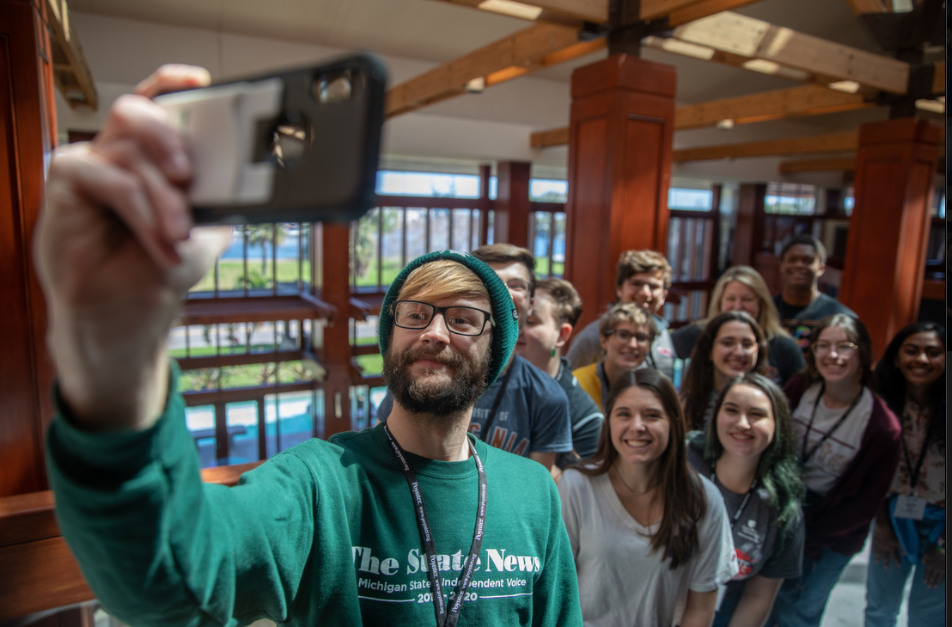In early March of 2020, with funding from Facebook, I arranged for 10 students from across the country to travel to Poynter to train as our first-ever Campus Correspondents cohort (yep, do that calendar calculus). They came from places like Michigan State, Stony Brook and Mississippi State.
Our plan was for each of them to go back to their campuses and train student groups like newspapers, sororities and political clubs to tell fact from fiction online.
Did I mention this was early March 2020?
By the grace of God, none of those students got sick from what would be an international crisis just a week later. Instead, we made a Plan B: virtual classroom visits. (Remember when that seemed novel?)
Now here we are, two and a half years later, and we’re still hard at work training college students to help their peers tell fact from fiction online.
Many of you have hosted our students in the past. Others still want to.
Now here’s your chance.
There are still a few spots open in our Campus Correspondents program for the fall in which one of our trainers will Zoom or Hangout or Team into your classroom for an engaging session on finding out what’s BS on the internet.
Simply fill out this Google Form, and we’ll send you a link to the portal to book a time. It’s that simple.
If you don’t want to commit to a virtual visit, consider this five-part online educational resource that your students can work through on their own time. And if you’re pressed, here’s a video our Campus Correspondents put together that highlights the top levels of our training.
We hope one of these tools works for you as we barrel toward the midterms on Nov. 8.
When you book a Campus Correspondent, not only do you support Poynter and our work with colleges, but you take an important step in showing your own students the value of information and skepticism.
We invite you to join our network of educators who’ve walked away from our training with students who are savvier, sharper and stronger at spotting mis- and disinformation online.
And goodness knows, we need citizens who know a fake when they see one.
Ideas for journalism education
Now listen
Here’s an interesting idea coming out of Murray State via Trusting News: “How journalism students are using audio boxes to explain their reporting process.”
Hold this up as an example
The Texas Tribune is putting on a clinic on audience-focused midterm reporting. “What you can expect from our elections coverage” has voters guides, explainers, call-outs and more. What do your students think of it? How does it differ from other election coverage you’ve seen?
Follow the money
What kind of tuition and fees hikes are planned for your university? Even if you’re lucky and you’re not experiencing any, report on it. And go deeper — do you have a handy guide posted to your website that outlines the breakdown of student fees and what they go towards? Often, schools don’t readily provide this information but it’s hugely readable. Find an administrator willing to go line by line to explain in detail what the fees are, how long they’ve existed, how they are adjusted, when/if they expire and what students can do to keep these fees low.
Contest open
This from my friends at the Reynolds Journalism Institute at Mizzou: The RJI Student Innovation Competition is now open.
They write, “The 2023 challenge is for students to come up with a utility journalism idea to test out in partnership with a local news source. Utility journalism, also known as service journalism, works to help communities solve problems, answer questions, and make big decisions in their lives.”
The first-place prize is $10,000, and the deadline to enter is Oct. 15.
‘Raw chunks’ — sounds gross but helpful!
I heard last week from Montclair State University adjunct professor Tammy La Gorce, who wanted to know where she might find unedited chunks of copy for her students to practice copy editing. It’s a great question.
Wattpad looks really promising — you could copy and paste some examples there, and those writers have put their work up for public consumption, though it’s fiction mostly.
Of course, you could use local newspapers or websites, but I think that sends the wrong signal to your students in most cases. Above all, don’t use your student newspaper.
Sure, they probably aren’t perfect and might be a good place to find some typos and structure that’s lacking, but you run the risk of deeply embarrassing the hard-working students who write, edit and lay out their school paper — and they may be in your class.
And now a word from our sponsors
Have I helped you, or has Poynter helped you? I’m looking for a few professors to give testimonials for our marketing materials. Send me a sentence or two about what’s working for you and I’ll reach out with more details!
Higher ed headlines
- How higher education lost its shine (Hechinger Report)
- You don’t have to go to J-school to get a journalism job. But it helps. (NBCU Academy)
- More Colleges Are Adding Diversity to Tenure Standards. But the Debate’s Not Settled. (Chronicle of Higher Education)
Great journalism to share with your students
- Kid Cudi Is All Right (Esquire)
- I smuggled my laptop past the Taliban so I could write this story (The Atlantic)
- Prison Money Diaries: What People Really Make (and Spend) Behind Bars (The Marshall Project)
Diversity, equity and inclusion
- What Happened to Black Enrollment? (Chronicle of Higher Education)
- ‘It’s unfathomable’: No arrests made 6 months after HBCU bomb threat (Politco)
- Inside the First Indigenous Sorority (JStor Daily)
This week in WriteLane
Go back to the very beginning at the beginning of your semester and have your students read Lane DeGregory’s Pulitzer Prize-winning piece, “The Girl in the Window.” Then listen to DeGregory and her editor, Maria Carrillo, discuss the 10-year anniversary of the story — its impact on them and their audiences, and hear some behind-the-scenes stories. This is a proven classroom winner.
One last thing
I love this comedian’s ongoing commentary/takedown of gender reveal parties on social media. The internet is wild, man.
Resources for educators
- Get access to a growing library of case studies — Professor’s Press Pass
- Subscribe to The Collective — Poynter’s monthly newsletter for journalists of color by journalists of color
- Help your students up their digital media literacy game with this new course from MediaWise’s Campus Correspondents on spotting and stopping the spread of misinformation. It’s free.
- United Facts of America: A Festival of Fact-Checking (Virtual event) — Sept. 27-29. Get tickets.







